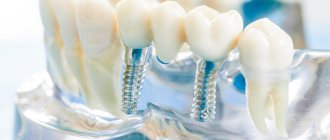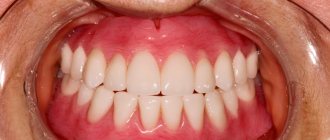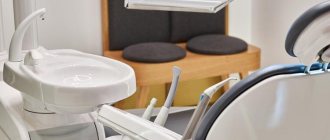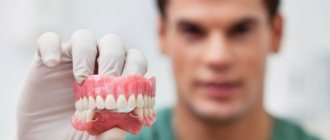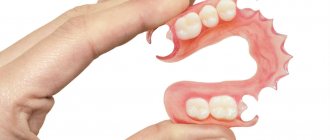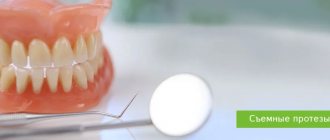Korostelev Egor Dmitrievich
Source:
Clinic “It Doesn’t Hurt!”
Enlarge
When making any removable denture (complete, partial), regardless of the material of the prosthesis (acrylic plastic, acry-free, nylon or clasp denture), the patient goes through the same steps. Usually you have to make 4 visits to the dentist.
Artificial jaws: types
First of all, let's define the terminology to make the following text easier to understand.
- Basis - the base, which looks very similar to the gum, fits tightly to the oral cavity. The borders are made of modern polymer materials.
- Fastening – various locks with hooks securing the entire structure to supporting healthy organs.
- Implants are elements firmly embedded in the base, replacing individual chewing units. In production, light components are used that are as close in color to real teeth as possible.
Classification by type
Types are divided according to the substances contained in the composition. However, a distinction based on how partial dentures are placed, how they are inserted and secured, and what the dentures look like is the most correct approach.
Lamellar
The most inexpensive and accessible way to restore chewing functions. The plastic base completely covers the curves in the patient’s mouth and the contours of the gums. They are attached to supporting intact masticatory organs. Acrylic, nylon, and other modern materials that prevent allergic reactions are used in the production of these implants.
Low cost with simple fixation are the main advantages. The age group of patients for their use is not limited. However, the restoration of chewing functions does not occur completely; diction may be impaired, and the structure does not hold well in the mouth. The photo shows the installation of removable plate and one-sided dentures on hooks.
Clasp
Artificial analogues are attached to a metal frame. Since the base is made of durable material, the product will last quite a long time. Installed using various hooks, crowns and other methods.
This type of substitution is not suitable for those who have allergic reactions to the main component. High cost is also a significant disadvantage. Among the positive features are strength, strong fixation, complete restoration, natural appearance.
Immediates
They cannot be considered a permanent solution, as they are temporary measures. The installation of partially removable dentures is shown in the photo.
For a short period of time they can completely restore all aesthetic and chewing functions. But, it should be remembered that their use is only possible when one or two damaged units are restored.
Low cost along with quick installation are positive aspects. Soft components make the implant unstable to heavy loads and greatly reduce its service life. The use of immediates is common in dental practice when it is necessary to prevent the displacement of remaining teeth towards the removed ones.
Fixed dentures
Fixed restorations include inlays, veneers, crowns and bridges. The manufacturing scheme differs only in small details. For example, let's take the manufacture of a bridge structure.
Preparation for the manufacture of a fixed denture begins with collecting anamnesis, making a diagnosis and preparing the teeth. The first clinical stage ends with the taking of impressions.
First laboratory stage
The impression technician makes a plaster cast and wax base with occlusal ridges. The model is then handed over to the doctor to determine the central occlusion. After this, the model goes back to the technician.
Second laboratory stage
The technician places the model in an articulator (a dental apparatus that simulates the closure of the jaws) and prepares models of ground teeth. Models crowns on abutment teeth and artificial teeth between them. Depending on how the denture is made, the technician makes metal crowns by casting, ceramic ones by pressing, and grinds zirconium crowns on a milling machine. The bridge is transferred to the orthopedist.
The dentist tries on the crowns and adjusts them. Notes any imperfections and sends them to the technician for final processing.
Third laboratory stage
The structure is polished and ground. In the case of metal ceramics, the metal base is processed and a ceramic coating is applied to it. The finished bridge is sent to the orthopedist, who fixes it on the patient’s teeth.
The production of dentures for the upper jaw follows the same protocol as for the lower jaw.
How to make a denture, a completely artificial false jaw: materials
The components that form the basis of such products determine the quality of human life. Good and durable, anti-allergenic, do not cause discomfort, are installed painlessly, quickly and easily. The main thing is that there is no rejection.
Prostheses from the low price segment are often manufactured in a short time. However, they do not tolerate heavy loads well, do not last long, and can cause unpleasant sensations: itching, irritation of the oral cavity.
Plastic
Affordable and widespread chemical material. It is used in all spheres of human life: from domestic needs to medical. It gained popularity due to its efficiency and easy processing.
Low cost greatly influenced its development in dentistry. The affordable price is perhaps its only advantage in this area. Simple installation, fastening of partially removable and fully overlay plate dentures with the palate has the following reviews:
- fall out;
- ugly appearance;
- cause severe discomfort while eating due to unevenly distributed load.
Particularly weak attachment in the lower jaw area. The sublingual space is uneven, so it is impossible to attach a classic suction cup to it. The problem is solved as follows:
- use special creams for retention;
- installation of the lower chewing part is carried out on living units.
Orthopedic products are held in place by clasps, which grip the implant at the base and give the structure the necessary rigidity. The most popular are removable dentures ivocap with the following pros and cons.
Positive traits:
- the upper jaw has good stability;
- low cost;
- common;
- suitable for repair;
- ease of construction;
- unpretentious in care.
Negative sides:
- a large frame takes up a lot of space in the mouth;
- clasps are noticeable with close eye contact;
- the lower part is poorly fixed;
- the alveolar arch and process gradually atrophy;
- short-lived.
Recommended as a temporary solution, or for complete/partial edentia.
Made from acrylic
The most inexpensive and widespread prostheses, which are based on polymer masses of low cost and quality. Among all lamellar ones, they are able to provide acceptable aesthetics. They are highly allergenic, fall out, break and cause discomfort.
Acry-free
Removable dentures or dentures made from an improved polymer relieve its owner from possible irritation of the oral cavity, are more durable, and reduce the risk of breakage.
An excellent option for temporary solutions while a high-quality and durable replacement is manufactured. People with hypersensitivity can easily wear them until full implants are inserted.
Spofadent
The base is made of three-layer plastic. They are characterized by durability, strength, resistance to chemical compounds, and visual appeal.
The design is loved by dentists and clients for its beautiful appearance. A colored complete removable denture is an analogue of living tissue.
IvoBase
Polymethyl methacrylate is an organic plastic that has innovative properties thanks to a unique creation method (the polymer is mixed in an injection device):
- greatly reduces the risk of an allergic reaction;
- prevents hypersensitivity;
- eliminates errors (low bite, large shrinkage).
Automation follows the entire technological process exactly. As a result, porosity decreases and strength increases. These properties ensure the durability of the entire system.
Vertext
Modern and thermoplastic, eliminates the use of monomer. Dryness, burning, allergic reactions are completely absent. The material is much stronger than analogues. Consequently, the basis is very thin. In turn, it increases the sensitivity of taste buds and articulation.
DeFlex
An Argentine company has made a breakthrough in dentistry by developing a polyamide that ensures complete transparency of the entire frame, including clasps. Transmitting light, it completely merges with the tissues of the oral cavity.
Widely used by athletes, police officers, and emergency services to provide jaw protection.
Nylon
The base is filled with soft nylon. 100% transparency ensures complete fusion with the mucous membrane. Clasps are made of the same material.
The patient quickly gets used to the foreign body in the mouth. High elasticity reduces stress on gums and soft tissues. The sufficient strength of the material used makes it possible to minimize the frame in order to maintain diction.
However, the pros turn out to be cons. To answer the described contradiction, it is important to understand the following question: how is a full-fledged nylon denture installed?
The thin and elastic component located at the base requires a mesh structure. When chewing hard food, fibers dig into the palate or gums, causing pain.
Advantages:
- quick addiction;
- 100% camouflage;
- biocompatibility.
Flaws:
- frequent hair loss requires you to always use fixing creams and ointments;
- chewing function – weak;
- expensive;
- lead to accumulation of plaque on the rough part;
- require adherence to a strict diet;
- the alveolar ridge bears the entire load.
Indications for use:
- partial edentia with preservation of supporting organs;
- in cases where aesthetics comes to the fore;
- The patient is allergic to acrylic.
So, we figured out how false jaws are made, the pros and cons of dental prostheses and various components. Let's move on to indications for the use of other types.
Immediate
Replace a unilateral included defect. The design can be created from any materials used in dentistry. Capable of restoring a row of holes. Also found under the name "butterflies".
Several artificial crowns are attached to a miniature base, secured with hooks and locks. Recommended as a temporary solution after removal of diseased masticatory organs.
For those who are going to install metal ceramics and do not have enough money, it helps to gain time to collect them. Some patients use it all their lives, replacing it with a new one after a few years.
Relevance of the problem – diversity of species
Dentistry is one of the oldest branches of medicine. Oddly enough, Pithecanthropus, Neanderthals, and our direct ancestors, the Cro-Magnons, had teeth pain. Already at the earliest stages of human history, the problem of replacing (prosthetics) a lost or fallen tooth arose. Until the beginning of the 19th century, practice followed the path of replacing like with like. The prosthesis was either a tooth of a deceased person of a suitable size or a tooth of an animal, ground to size. In rare cases, prosthetics were made from precious stones or metals.
Modern prostheses have incorporated technologies that make the design as light and cheap as possible. Ceramic metal, which was popular 10 years ago, is already a thing of the past. It is being actively replaced by polymers, which are not inferior in strength to metal and porcelain, but are an order of magnitude cheaper. In addition, most polymers can be repaired and restored in the event of loss of a component element. For each type of dentures, our own repair and restoration technologies have been developed. Not all of them can be reproduced at home.
Conditionally removable
Anyone who has ever gone to the dentist for dentures is concerned about how to make them, who makes and inserts dentures on hooks, what methods of fastening exist, and what they look like on the teeth.
The design received its name due to special fixation methods. Special crowns and clasps ensure a secure fit in the mouth. They will never fly out on their own. You can remove it using special skills (usually a dentist does this).
Clasp
This type of implant is described above. Additionally, 3 types of structures should be distinguished:
- Clammers. The metal claw mount provides a secure fit and poor aesthetics.
- Lock. Divided into two parts: the first on the side, the second on the inside. Installation of such a connection requires grinding of adjacent elements.
- Telescopic. The inner crown is made of solid metal, onto which an outer structure (for example, ceramic) is placed.
Indications for use:
- edentia, in which at least 5 teeth are preserved;
- more than three units in a row are missing;
- mobile teeth (loose);
- other implants cannot be installed.
Quadrotti
Clasp or clasp without metal. Biocompatible plastic is at the core of the entire design.
Positive traits:
- there is no need to grind the supporting parts;
- the material does not cause allergies;
- cheap;
- the patient gets used to it easily;
- the chewing load is distributed correctly.
Negative qualities:
- despite greater stability compared to fully removable ones, the fixation is weak;
- the classic arc has high strength;
- service life is 3-4 years.
How a new generation of complete removable dentures are attached without a palate and what they are like
It is based on two materials:
- hard acrylic for bases and implants;
- soft polyurethane for fasteners.
At the base of the mechanism is an imitation of gum, which ensures a strong fixation. Dentists are still arguing about what type they should be: completely removable or not.
Cement for dental crowns
Causes of crown loss
What to do if a dental crown falls out
Cement for dental crowns
Features of various cements for crowns
Prevention of crown loss
To restore a badly damaged tooth, a crown is needed. This is an orthopedic structure in the form of a cap, which is attached to the tooth using special cement. It protects the tooth from damage and maintains its functionality. However, due to improper hygiene or unprofessionalism of the doctor, the crown may fall off. What to do if a dental crown falls out? Can I attach it myself? Or is it better to seek help from a doctor?
What to choose if you are completely missing teeth
If the doctor has not identified any contraindications, separate implants are recommended. However, you can look towards removable or partially removable options.
Partial absence
Conducive to installing butterflies and crowns. Any of the methods described in the article is suitable for replacing a bite. Only a qualified specialist can provide the correct advice in each specific case.
For the upper and lower parts of the mouth
If we are talking about removable structures, plate options can be used at the top, and fixed ones at the bottom. This advice is based on the anatomical features of the jaw. However, only the doctor will provide the correct solution.
Choosing a clinic for prosthetics
Choosing a doctor for removable prosthetics is not an easy task. In this case, the specialist will have to take into account a lot of characteristics of the patient’s body and his oral cavity. Therefore, it is important to trust a true professional to install removable dentures.
It is the doctor you should look for for any prosthetics, and in which clinic he works is not so important.
Internet resources can also help you choose a specialist or clinic for installing prostheses. In most cities in Russia and Ukraine there are forums where reviews of dentists from various medical centers, clinics or dental offices are published.
Also, the prosthetics hotline smile-at-once.ru will help many people to choose real professionals in the field of dentistry. This site was created thanks to the Dental Association and is registered by the Ministry of Justice. This hotline is not a commercial project. In this case, you can go to the website or call the phone number provided and get a free consultation at several clinics. Thanks to this program, you can also use installments or a loan when paying for prosthetic services.
There is no need to be afraid of removable dentures. To successfully use such structures, there must be a “consensus” of the professionalism of the prosthetist, the correctly selected removable structure and the patient’s desire to learn to live with dentures. It is quite possible to live a full and quality life with dentures at any age. At the same time, people around them are often completely unaware of the presence of a prosthesis in a particular person. Take care of your teeth!
Sources used:
- Naomi Yamamoto, Masamitsu Oshima, Chie Tanaka, Miho Ogawa, Kei Nakajima, Kentaro Ishida, Keiji Moriyama & Takashi Tsuji, “Functional tooth restoration utilising split germs through re-regionalisation of the tooth-forming field”, Scientific Reports
- “Cosmetic dentistry is not a recognized specialty.” The Journal of the Michigan Dental Association.
- “Removable dentures: a textbook” (Mironova M.L.)
Service life and care
Durability depends on materials, quality of installation and maintenance. The following tips will help you make it last as long as possible:
- every 6 months it is necessary to visit a doctor to assess the condition - especially when using rigid structures;
- 2 times a day you need to treat the oral cavity and removable jaws with a solution or rinse with clean water;
- follow individual recommendations received from your doctor.
The article answered the questions: what is a complete and partially removable denture, what types are there in dentistry, which are better, what the price depends on. It should be noted that the text is not a guide to action; its main purpose is to introduce the reader to the varieties. If you have any questions or pain, please contact your dentist.
